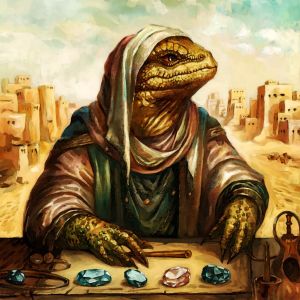Culture and Society of the Gilaari
Introduction

The Gilaari are a nomadic people native to Zanarak, known for their craftsmanship, adaptive traditions, and spiritual connection to the shifting desert city of Mirajhar. Gilaari culture emphasizes communal resilience and ecological harmony.
Societal Structure
Gilaari society is mostly decentralized, with functional roles distributed across specialized castes:
- Navigators and Guides– Experts in desert navigation, capable of forecasting sand shifts.
- Artisans – Builders, glassworkers, and spiritual attendants who preserve cultural practices.
- Merchants - Shopkeepers and mongers.
- Elders - Gilaari from all caste who have achieved old age.
Gilaari homes are typically constructed from lightweight sandstone and resins, allowing them to be disassembled and relocated in accordance with the city’s motion. Markets and public spaces are modular, shifting with the city's reconfiguration to ensure continuity of trade and social function.
Literature and Oral Traditions
Gilaari cultural memory is preserved through oral storytelling.
Music and Dance
Performing arts among the Gilaari reflect the rhythms of shifting dunes and the transient nature of existence.
Art and Craftsmanship

Gilaari artisans work with natural desert materials to create portable, resilient, and symbolically significant works.
Medicine and Healing
Healing traditions focus on temperature regulation and wound stabilization.
Clothing and Adornments
Gilaari attire is both protective and symbolic, reflecting their identity and the necessity of mobility. Most Gilaari wear layered robes and adorn themselves with small glass jewelry.
Cuisine
Gilaari cuisine is practical, using preserved ingredients and plants adapted to arid conditions.
